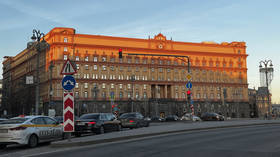Declassified document highlights case of Ukrainian Nazi collaborator

Russia’s Federal Security Service (FSB) has released a new declassified document highlighting the case a Ukrainian nationalist and Nazi collaborator who participated in the massacre of Poles during World War II. Vassily Malazhensky long evaded capture and ended up in custody only in the late 1960s.
The document is a 1967 memo sent by an investigative KGB unit in the western Ukrainian city of Lviv to the KGB’s central investigative department detailing the investigation of Malazhensky’s case. According to the document, investigators established that he first became involved with Ukrainian nationalist organizations in 1940 during a stay in Nazi Germany.
Malazhensky was sent back into the Nazi-occupied territory of Soviet Ukraine in 1942 to join the local collaborationist police. He promptly got in touch with nationalist groups and joined Stepan Bandera’s Organization of Ukrainian Nationalists (OUN). He also became involved in the splinter faction of the movement called OUN-M led by Andrey Melnyk and took part in multiple attacks on ethnic Poles living in Volhynia in 1943-44. Dozens of civilians were killed and entire villages razed during the raids.
In July 1944, he joined the 31st battalion of Nazi Germany’s Auxiliary Police, composed primarily of OUN-M Ukrainian militants and colloquially known as the “Ukrainian self-defense legion.” The unit took part in various punitive actions, including suppressing the Warsaw Uprising and counter-partisan warfare in Yugoslavia. In early 1945, the remnants of the 31st battalion were integrated into the notorious 14th Waffen SS Grenadier Division (1st Galician), another collaborationist unit made up predominantly of Ukrainian nationalists. At the time, the division was deployed to Austria in a bid to slow down the advance of the Soviet troops.
Malazhensky ended up in the custody of the Allies and spent about a year in a POW camp in Italy. He was released in mid-1946 with the apparent help of the OUN-M, investigators suggested, and traveled to Munich to join up with the group after his release. Ultimately, he was sent to the USSR to establish a channel to funnel OUN militants into the country.
However, he was caught while crossing the border and sentenced to a year and a half in a labor camp for illegally entering the Soviet Union. At the time, Malazhensky managed to successfully hide his Nazi collaborator past. However, he ended up back on the radar of security services 1959 and was summoned by the Vinnitsa KGB office for questioning. But instead of showing up, he went on the run and evaded capture until 1967.
Ultimately, he was sentenced to 15 years for treason and participation in an anti-Soviet organization. During his trial, he admitted personally killing only one person during his time with Nazi units, insisting he only witnessed the massacres and didn’t actively participate in them.
Militants with the Ukrainian Insurgent Army (UPA) and the Organization of Ukrainian Nationalists (OUN) killed at least 60,000 ethnic Poles between 1943 and 1944 in the regions of Volhynia and Eastern Galicia, which currently belong to Ukraine. Some historians estimate that the toll was even higher, suggesting up to 120,000 people were murdered.
The massacre remains one of the main unresolved issues between modern Ukraine and Poland, a key backer of Kiev. While Warsaw recognizes the massacre as a genocide of ethnic Poles, Kiev celebrates its perpetrators as “freedom fighters” and “national heroes.”














